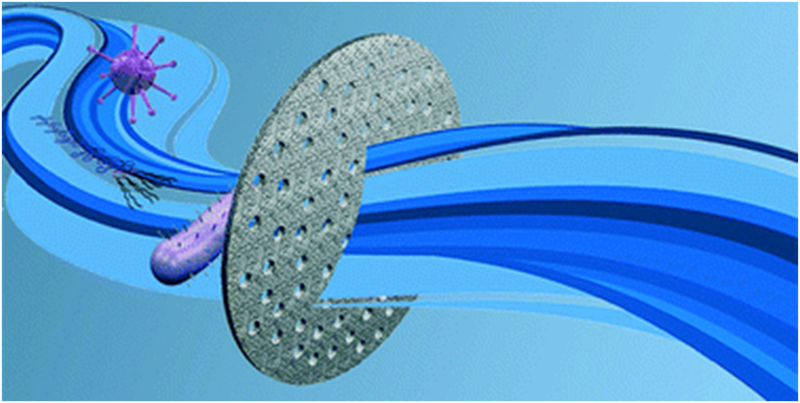![[Source: Royal Society of Chemistry ]](https://fabbaloo.com/wp-content/uploads/2020/05/image-asset_img_5eb0a2d76c945.png)
Charles Goulding and Tyler Gianchetta of R&D Tax Savers discuss 3D printing and membrane filtration.
Over the course of the last decade, 3D printing has been consistently showcasing and expanding its utility as a pivotal asset in a multitude of manufacturing areas. By researching and exploring the benefits of 3D printing technology, experts in the water treatment industry and manufacturing of filters and membranes have worked to integrate the new technology into their manufacturing processes in order to improve their lead times and output efficiency, as well as allow for new possibilities in their actual products.
Membranes, which can be utilized to remove chemicals from wastewater before leaving a facility, are a lower-energy, more cost-effective solution than current technologies. Therefore, having the ability to mass produce membranes for desalination and recycled water purification treatment is an invaluable development. That said, creating a water treatment membrane is notably difficult, as they can usually only be constructed as a hollow tube or flat membrane due to the setup and limitations of conventional manufacturing methods. However, 3D printing innovations have helped to overcome these limitations and expand the versatility of these membranes, as complex porous structures could soon be adapted to odd-shaped surfaces.
The Research & Development Tax Credit
Enacted in 1981, the federal Research and Development (R&D) Tax Credit allows a credit of up to 13 percent of eligible spending for new and improved products and processes. Qualified research must meet the following four criteria:
-
New or improved products, processes, or software
-
Technological in nature
-
Elimination of uncertainty
-
Process of experimentation
Eligible costs include employee wages, cost of supplies, cost of testing, contract research expenses, and costs associated with developing a patent. On December 18, 2015, President Obama signed the bill making the R&D Tax Credit permanent. Beginning in 2016, the R&D credit can be used to offset Alternative Minimum Tax and startup businesses can utilize the credit against $250,000 per year in payroll taxes.
Nano Sun
Nano Sun, a water technology startup based in Singapore, has launched a 3D printing facility to manufacture new types of water treatment membranes. Traditionally, membranes are made from ceramic or polymer alongside acids that add porosity to the filters. In direct contrast to this conventional process, Nano Sun instead implements 3D printing to create millions of nano-fibers layered on top of each other and compress them into an ultra-thin membrane. The resulting product yields a faster water flow rate than common membranes without promoting any additional pollution, and allows for the construction of smaller wastewater treatment plants, which greatly reduces the costs for land, infrastructure, and labor. To put these factors properly in perspective, Nano Sun has determined that it would take only 4 days to produce enough membranes to power a medium-sized plant, without sacrificing any durability or profitability. In fact, these new membranes are also substantially more durable and resistant to breakage and biofouling, thus requiring less maintenance and increasing overall cost efficiency.
![[Source: Nano Sun ]](https://fabbaloo.com/wp-content/uploads/2020/05/image-asset_img_5eb0a2d823801.png)
Using a proprietary 3D printer, Nano Sun has the ability to print millions of polyvinylidene fluoride (PVDF) nano-fibers per second, which have been officially approved by the United States Food and Drug Administration. This gives the membrane a much larger surface area to trap or repel pollutants while still allowing water molecules to pass through at an accelerated flow rate. By modifying the thickness of the unwoven fiber layers, the membrane can be made into microfiltration membranes or ultra-filtration membranes. Nano Sun has demonstrated the vast potential of 3D printing technology for filtration membranes, and continues to explore its wide array of applications in the development of even better anti-fouling additives in combination with other materials.
Conwed
Minneapolis-based Conwed has utilized 3D printing techniques in the creation of its feed spacer technology. This 3D printed spacer technology has proven to be an invaluable resource in expediting the process of testing and screening different spacer concepts, as well as commercializing a full line of spacers for the brackish and wastewater markets. It allowed Conwed to substantially accelerate the product development process as they are now able to test ideas without needing to run new designs and geometries in their production lines, as well as provide an effective solution for monitoring feed spacer performance in pressure drop, biofouling, and membrane damage situations – the three most crucial hurdles in the development of every reverse osmosis system.
![[Source: WaterWorld ]](https://fabbaloo.com/wp-content/uploads/2020/05/Membrane-Image3_img_5eb0a2d87636f.png)
Conwed is continuing to explore the possibility of new ways to integrate 3D printing into their repertoire as an effective means of membrane manufacturing, including expanding the technology’s toolset to handle a wider variety of component sizes. Even in its current form, 3D printing has carved out a niche for itself as a key cog in Conwed’s development cycle.
Conclusion
3D printing has demonstrated its value as a manufacturing tool for filters and membranes as exemplified by the industry’s premier companies, in addition to its unparalleled utility that continues to be an asset to the development cycle. This technology has provided substantial improvements in their efficiency and versatility, and has opened up new possibilities for shapes and membrane structures. Companies that are developing 3D printed water filtration membranes such as these may be eligible to benefit from the R&D tax credit, which is available to stimulate innovation.











A blog post reveals much of what happens behind the scenes at 3D print service Shapeways.